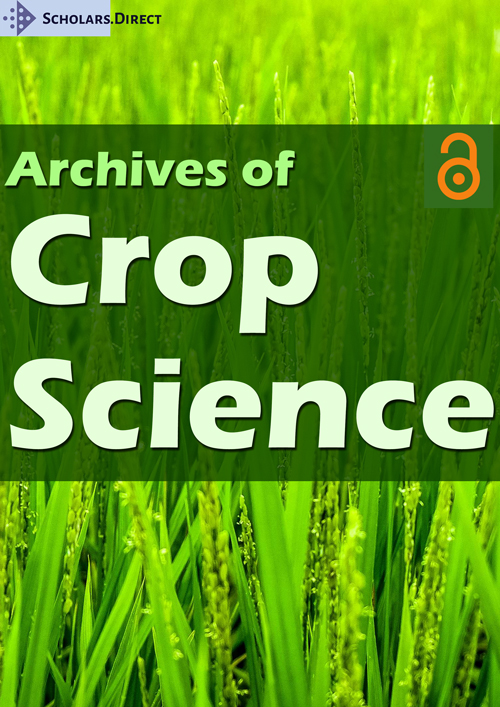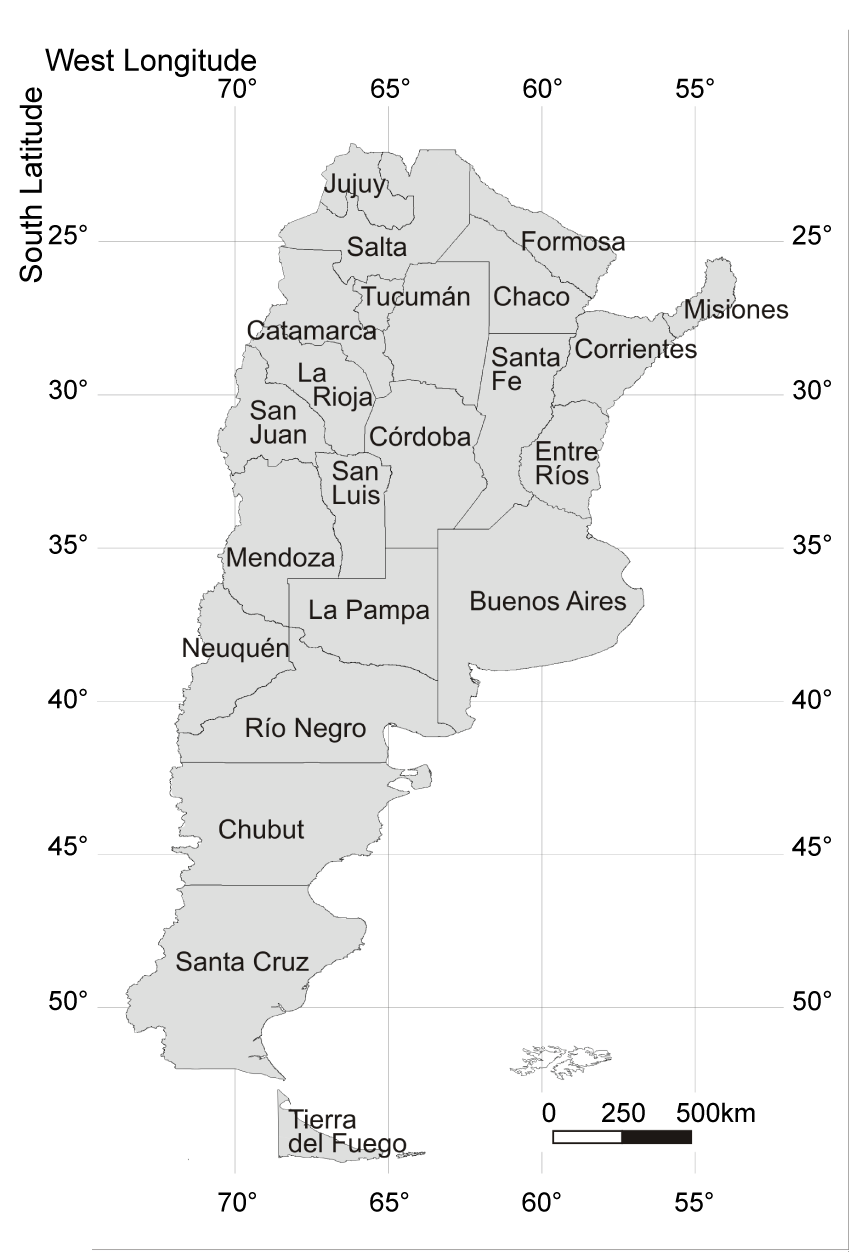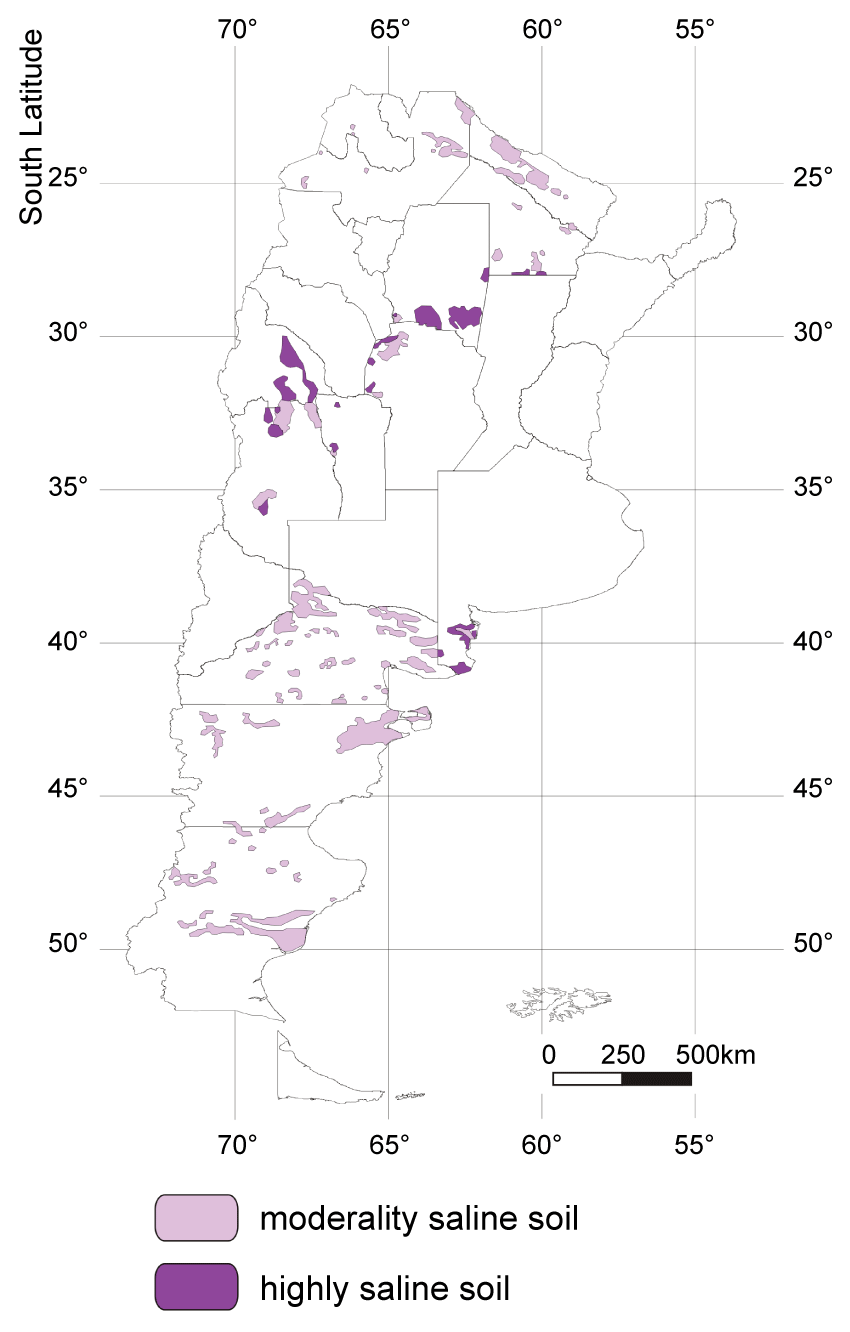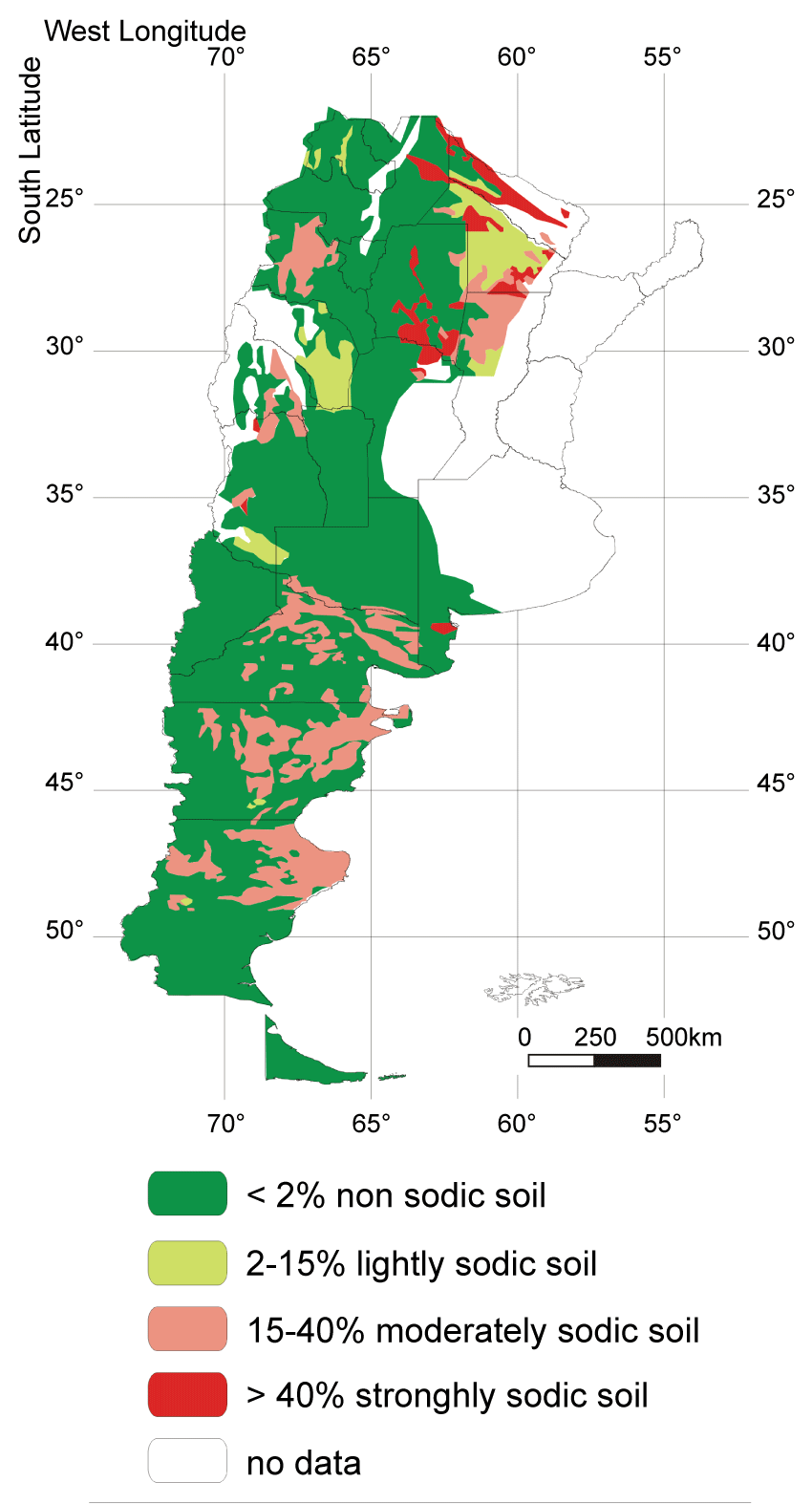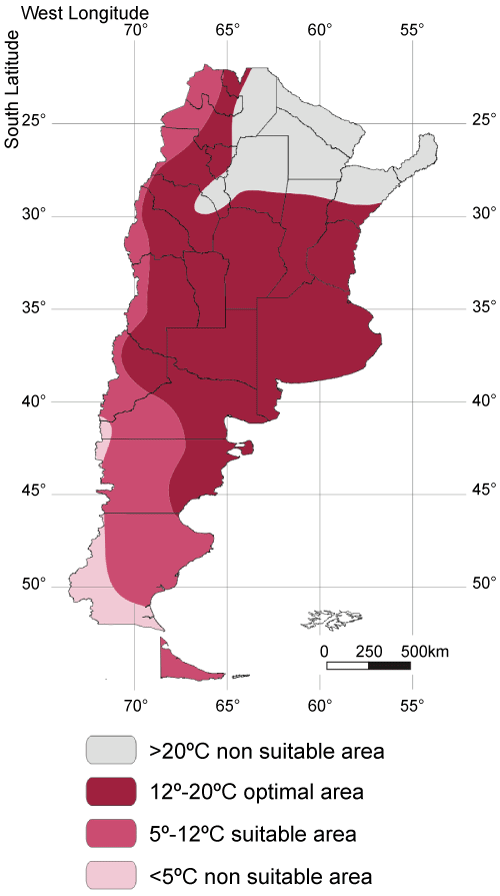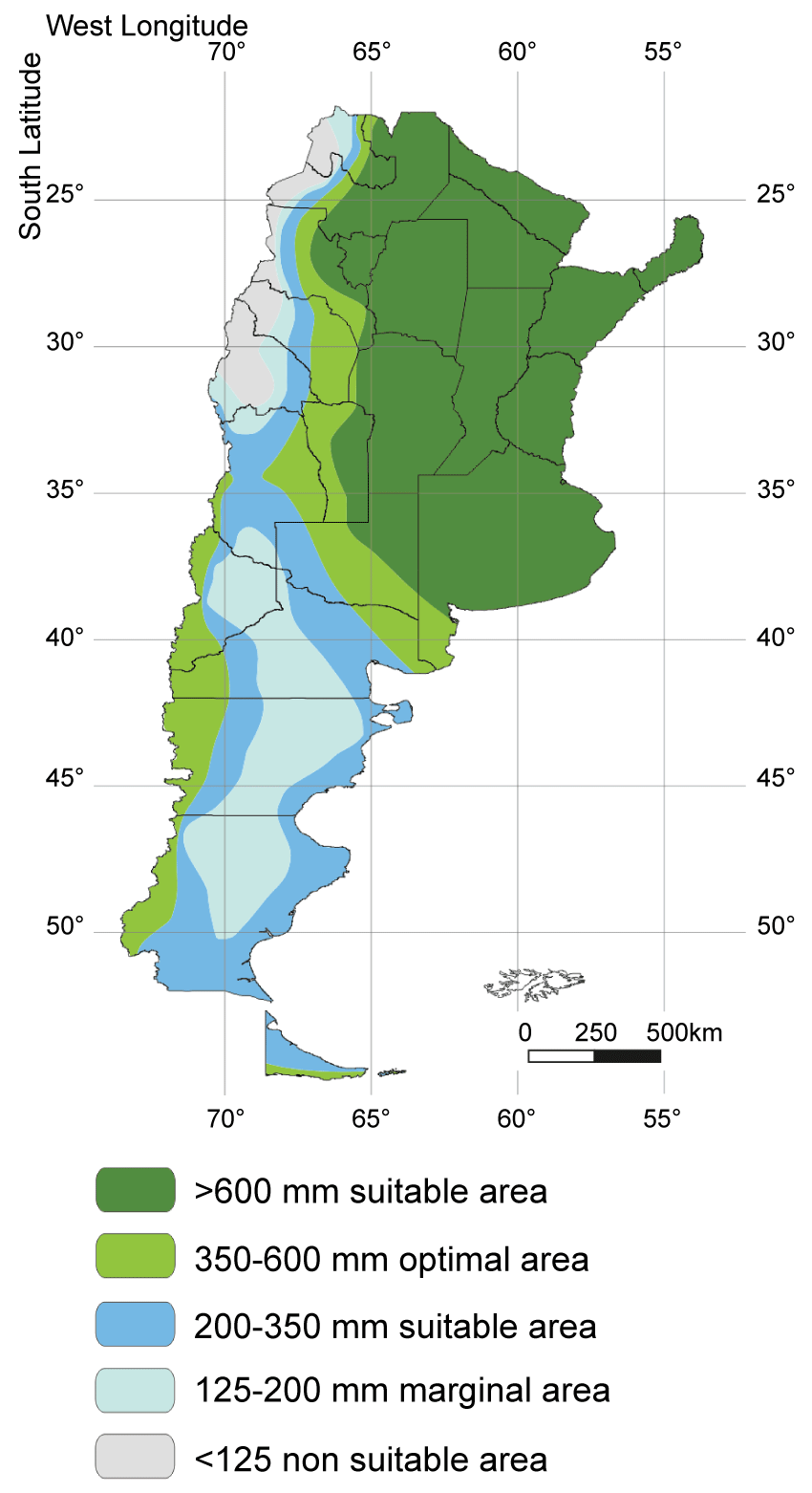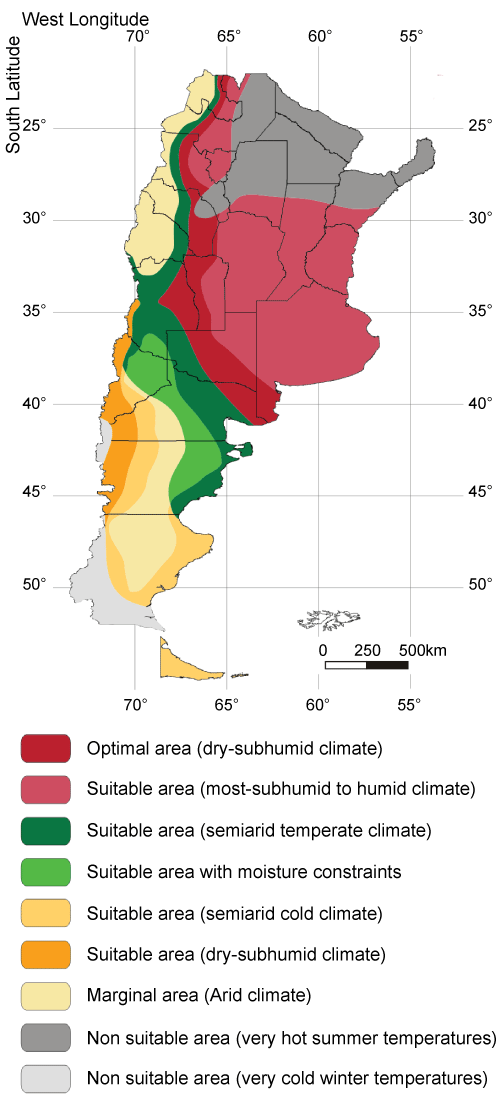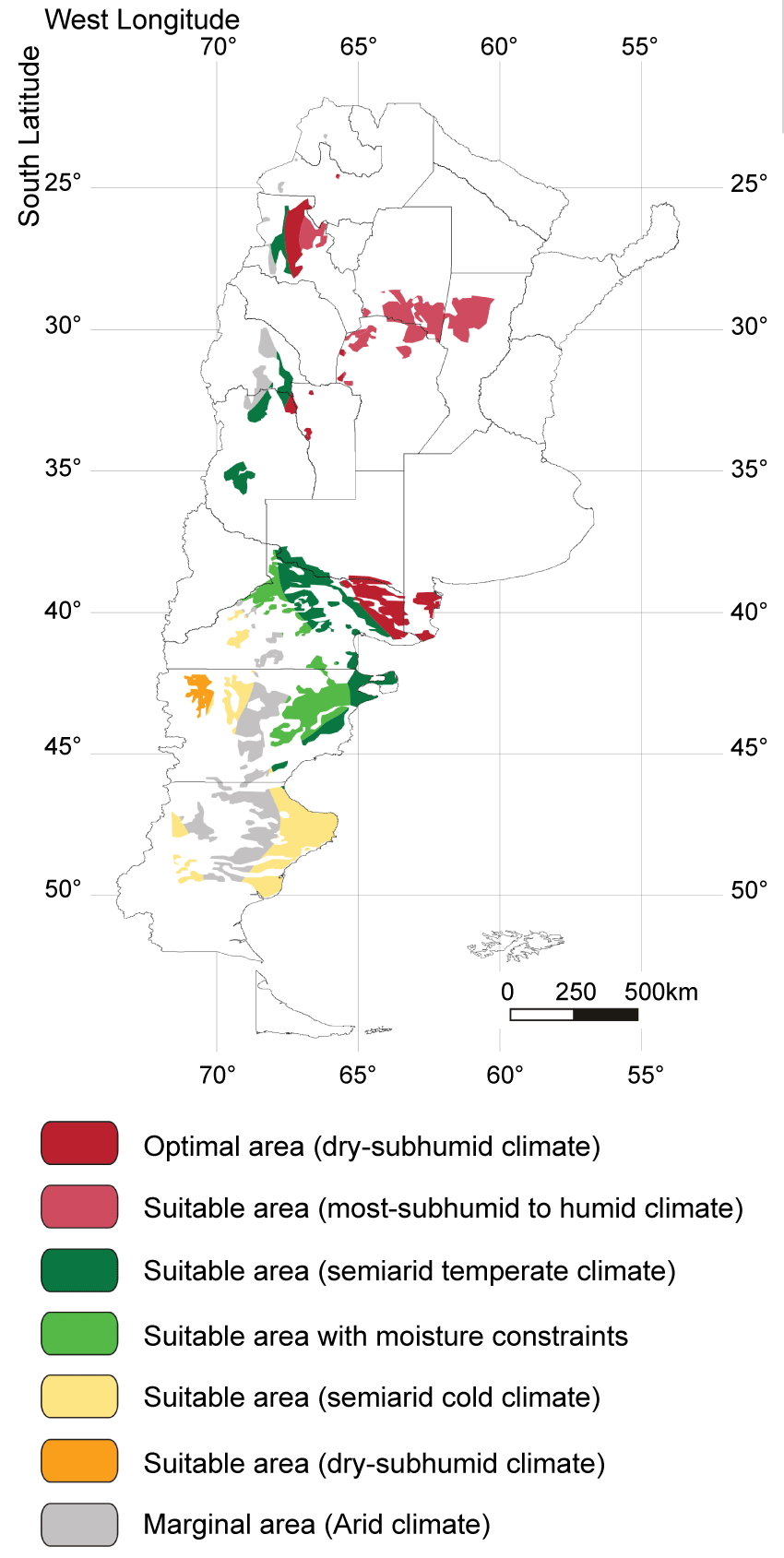Agro-Ecological Zoning for Tall Wheatgrass (Thinopyrum Ponticum) as a Potential Energy and Forage Crop in Salt-Affected and Dry Lands of Argentina
Abstract
Tall wheatgrass (Thinopyrum ponticum previously Agropyron elongatum) is the most disseminated halophyte species cultivated for forage on hydro-halomorphic soils in the world. In Argentina, it is used for direct pasturing, hay and silage. The traditional cultivation area comprises poorly drained soils of the Pampean prairie, particularly the Salado river basin and the Semiarid Pampean Region. It is usually sown in Autumn, but due to its high resistance to frost, it can be also sown in Winter. It is naturalized in several provinces.
The objective of the present work was to identify the geographic areas for development of tall wheatgrass on halomorphic soils in Argentina for forage and as feedstock for bioenergy. To define the agroclimate in Argentina, we considered the thermal and hydric limits of the species in its place of origin and in locations where it is successfully cultivated around the world. The agro-climatic indices were then calculated based on the climatic data provided by the National Meteorological Service for the period 1981-2010. The maps corresponding to the bioclimatic indices were drawn using a Geographic Information System. The map defining agroclimatic suitability was obtained by overlaying these maps. This zoning was finally superimposed on the drylands saline and alkaline soils in the country, thus defining the agro-ecological suitability of Argentina for this species under different moisture regimes: moist-subhumid, dry-subhumid, semiarid to arid climate. The agro-ecological zoning shows the potential growing areas for tall wheatgrass in Argentina on soils with halomorphism processes under dry climates. The present is pioneering work because there are no previous studies on the possibilities of producing tall wheatgrass for bioenergy in Argentina.
Keywords
Tall wheatgrass, Bioclimatic requirements, Agroclimatic zoning, Saline and alkaline drylands, Agro-ecological zoning, Argentina
Introduction
Agroclimatic zoning involves the division of an area of land into climatic resource units. These have a singular combination of climatic characteristics, which in turn define the potentials and constraints for land use. Agroclimatic zoning can be described as the division of an area according to how favorable it is for cultivation. The maps are the geographical representation of the intensity, frequency, variability, time of occurrence, or any other feature that presents a spatial agroclimatic index. The maps facilitate the localization of optimal, suitable, marginal and/or non suitable areas. Through agroclimatic zoning, areas with different potential yields can be identified. Currently, this zoning is done through Geographic Information Systems (GIS), which exhibit higher precision and integrative power than traditional maps. Geographic Information Systems admit amplified analyses compared to conventional maps, besides facilitating its storage and display [1].
In Argentina, there are approximately 20 million hectares of salinity-affected soils, located in areas both with dry and humid climates. Furthermore, around 35% of irrigated lands in Argentina have anthropic salinity problems. Currently, secondary salinization produced by deforestation, overgrazing and displacement of cattle production towards marginal zones exacerbate this problem. In this context, the introduction of salinity-tolerant forage species constitutes one of the most effective strategies to recover and/or enable production on saline soils [2].
The main drawbacks to forage production on halomorphic soils are deficient drainage, salinity and the existence of a shallow water table. However, many native species and pasture forages tolerate droughts, flooding and edaphic salinity. One of the most relevant evolutionary features of native and/or naturalized species is their adaptation to extreme environmental and management conditions in marginal lands. These can range from low fertile or hydro-halomorphic soils to lands subjected to over or sub-pasturing conditions. This evolutionary characteristic has resulted in enhanced genetic variability and phenotypic plasticity in the majority of pasture species.
Characteristics of tall wheatgrass
Tall wheatgrass is a perennial species of the Poaceae family, with a fall-winter-spring cycle. Its growth habit is cespitose, and it produces many tillers that form dense clumps. The species is also known as: Agropyron elongatum (Host) Beauv., Elytrigia elongata (Host) Nevski, E. pontica (Podp.) Holub, Elymus varnensis (Velen.) Runemark, Lophopyrum elongatum (Host) A. Löve and Thinopyrum ponticum (Podp.) [3,4].
The species is native to the Eastern Mediterranean region, from South Europe to Asia Minor and Crimea, where it is found in saline meadows and across beaches.
Tall wheatgrass is a summer-active, perennial grass that grows best in late spring and summer with adequate water availability [5,6]. Growth diminishes in wintertime. It is classified as C3 plant with cool season characteristics, and its water use efficiency in slightly saline habitats differs according to the season [7,8]. Based on its adaptability to different environmental conditions, rather than on its ecophysiology, several cultivars have been developed in Europe and Asia. Thinopyrum species are cespitose or rhizomatous perennials, and the roots of T. ponticum are fibrous and can reach 3.5 m in length. The plant can grow as high as 50-200 cm [3,9]. The stems are robust and glabrous [9] and the leaves are large and somewhat hard, with a green-grayish color, with marked veins.
The tall wheatgrass in Argentina
Tall wheatgrass was introduced in Argentina in the 1960's and it has naturalized in several environments in the Pampean Region, and also in different provinces: Chubut, La Pampa, Salta, Tierra del Fuego [10,11]. Notwithstanding its short history in Argentina, several populations developed in different agro-climatic districts and diverse edaphic micro-environments in the Pampean Region. These populations presented different characteristics and phenotypic variability pertaining to growth habits, foliage colors and sizes, height, number of tillers and flowering types. The variability detected is auspicious, as the most promising materials can be further evaluated to determine their forage potential in more complex assays and in scenarios that most closely resemble their use and management in the Pampean Region.
In the Pergamino INTA Experimental Station, recent studies showed the existence of widespread genetic variability in naturalized populations in the Salado river basin, in the province of Buenos Aires. This paved the way to breeding programs to obtain new and improved cultivars, particularly compared to the old cultivar called "El Vizcachero INTA", which is widely disseminated across the country. "Atahualpa INTA" derives from a selection made with plants adapted to saline-sodic environments, and it stands out due to its strong initial growth, forage and seed production, and its high autumnal digestibility. The "Atahualpa INTA" cultivar produced 15.79 ton/ha forage in 7 harvests (September through July). In a Typic natracualf fertilized with 150 kg N/ha, the accumulated of 6 harvests (October through January) amounted to 8.17 ton/ha (28% more than common tall wheatgrass). Autumn dry mass had a 67% digestibility and it decreased as the crop entered reproductive state. In the vegetative state, "Atahualpa INTA" plants have dark green leaves that turn grayish in Summer, and its flowering cycle is premature compared to the cv "El Vizcachero INTA". The "Tobiano INTA" variety is characterized by its high forage production, which reaches 23 ton/ha/year of dry matter, a 54% increase compared to the traditional "Vizcachero INTA" variety, with yields of 15.3 tons DM/ha/year.
Assays carried out in the INTA Santa Cruz Experimental Station, in the semi-arid region of that province (150-250 mm), concluded that, although pasture implantation is difficult, productions of up to 2 tons DM/ha are possible. The possibility of using tall wheatgrass and Agropyron cristatum under these environmental conditions has been demonstrated by the survival of these pastures through the years. Precipitations above 250 mm afford more successful and enduring pastures [12].
The traditional cultivation area comprises all the Pampean praire in poorly drained soils, the Salado river basin and the Semiarid Pampean Region. It is sown in Autumn, but due to its high frost resistance, it can be sown even in Winter. In the Province of Buenos Aires, flowering begins in late November and continues until January [11,13]. Despite the species' importance, no efforts have been made in Argentina to obtain new varieties that improve some of the shortfalls of existent cultivars, usually in relation to the implantation celerity, early forage production and quality of DM after flowering.
Possible uses of the species
This species is widely sown in alkaline soils in USA, Canada, some northern regions of Europe and Central Asia, since it is one of the most salinity tolerant pastures [14]. It is a forage species useful in humid and waterlogged soils in winter and dry soils with crust formation during the summer [5].
In Argentina, it is used for direct pasturing, hay and silage [15]. Direct pasture has to be alternated with rest periods. Intense and frequent defoliations should be preferably avoided because they can compromise regrowth and cultivation permanence. Booting Stage must be avoided through mechanical weeding because the hard reeds can damage the animals. Digestibility of dry matter ranges between 65% and 50% in early tillering and ripening, respectively. Forage production from tall wheatgrass is approximately 6.5 to 8.5 tons DM/ha [11]. It is a species that can consociate with Medicago sativa, Bromus unioloides and, in saline soils and lowlands, with Melilotus albus and Melilotus officinalis.
This species has been employed to protect horticultural transplants in the San Rafael and General Alvear zones (Mendoza). When tall wheatgrass is sown in Autumn, it provides a safeguard in Spring by diminishing the wind speed. This, in turn, helps avoid soil erosion, mechanical damage to the cultivation and evaporation, resulting in increased production, particularly in arid regions and in years with adverse climates [16]. The seed is inexpensive and the cost of implantation is low. Furthermore, it is a perennial species not affected by frost. The seed can be harvested from the same curtain. The plant has no health problems and it is easily eliminated.
Yields are very high when the humidity conditions are favorable. Seed yields vary from 382 to 717 kg/ha. According to the phytomass archives [17], annual productivities range from 2 to 15 tons/ ha of phytomass convertible into bioethanol or biogas. This species has a prolonged productive period (more than 10 years).
Since its palatability for livestock is low, it could be used for combustion in industrial boilers to produce electricity. Recently, European studies have analyzed this species and recommended it for semiarid areas as a novel energy crop. Tall wheatgrass has recently been introduced into cultivation in Hungary to provide biomass for solid biofuel energy production [18].
Although the technology for converting cellulosic biomass into ethanol has not been established yet on a commercial scale, researchers have reported the potential use of forages as dedicated energy crops.
Ecological requirements
According to Duke [17], the species is quite flexible as to its habitat, and it can prosper in a diversity of climates: tropical wet with dry winter (Aw), tropical wet (Ar), steppe or semiarid (Bs), subtropical with dry summer (Cs), temperate oceanic (Do), temperate continental (Dc), temperate with humid winter (Df) and temperate with dry winter (Dw).
The species inhabits regions with annual precipitations in the 300 to 2100 mm range, but it can also grow in areas with annual rainfalls of 125-200 mm [19]. The optimum range is 350 to 600 mm [20]. According to Heath [21], in the arid zones of South Australia, where rainfalls are approximately 125 to 200 mm annually, it is recommended for recovery of saline soils.
Temperature is the main problem for its dissemination. It grows in regions where annual temperatures surpass 5 °C and are equal to or lower than 20 °C. Although it tolerates daily temperatures ranging from 2 °C to 25 °C, the optimal range is 12 °C to 20 °C. Flowering is induced by long days (> 14 hours) and crop cycle ranges from 120 to 270 days [20].
According to Plants for a Future (ND) [22], the USDA hardiness for tall wheatgrass extends from zone 5 to 9 (-7 °C to -29 °C). A hardiness zone is a geographically defined area in which a specific category of plant can grow, and it is defined by climatic conditions, including its ability to endure the minimum temperatures of the zone. This classification was developed by the United States Department of Agriculture and later adopted by other countries. The extremes of winter cold, informed by the hardiness zones, determine whether a plant species can be cultivated outdoors at a certain location. These limits are defined by the average annual minimum temperature.
In Argentina, tall wheatgrass is sown in March-April. It needs 150 degrees-over 0 °C from sowing to emergence. As a result, the later it is sown, the longer it will take to emerge, and the seed will be exposed longer to adverse factors. While sowing to emergence takes longer in cold than in warm weather, the thermal time in each case is very similar. The base temperature for growing is 4.5 °C. Germination is relatively easy, and 90% of the seeds germinate with 7 consecutive days of approximately 16 hours dark per day and 18 °C-20 °C air temperatures.
The species lives in soils with pH ranging from 5.3 to 9.0 [19]. It can grow with salinity values surpassing 10 dS/m [20], but it grows better with 16-32 dS/m, although it tolerates up to 40 dS/m. It can tolerate soils poorly (saturated > 50% of year), well (dry spells) and excessively (dry/moderately dry) drained [20]. Although it prefers loamy and fertile soils, it is very common in clayish, alkaline, poorly drained and sodic soils with pH > 8, Electrical conductivity CE > 5 dS/m and ESP > 15. It can also prosper in low-fertile sandy soils.
Tall wheatgrass is particularly appropriate to sowing in "hard-pan" situations i.e. where the soil is wet or waterlogged during winter and dries to form a hard crust over summer. This was observed in trials near Hamilton, Queensland, (Australia) where tall wheatgrass was the only subsisting species in a typical hard-pan saline site [5]. Weimberg and Shannon [23] related high forage production of tall wheatgrass under saline conditions to several factors: turgor maintenance, lower Na/K ratios, and mechanisms for the partial exclusion of Na in leaves.
The objective of the present work was to design an agro-ecological zoning model to delimit the potential cultivation areas for tall wheatgrass on Argentinean halomorphic soils under dry climates, to produce pasturage or lignocellulosic material for biofuel.
Materials and Methods
Study area
The area studied was the Argentine Republic. The country borders to the North with Bolivia and Paraguay; to the South with Chile and the Atlantic Ocean; to the East with Brazil, Uruguay and the Atlantic Ocean and to the West with Chile (Figure 1).
As a result of its vast territory, Argentina presents exceptional climatic diversity. Various geographic factors influence the climatic characteristics of the different regions. One of these is latitude: the Argentine Republic is characterized by its great latitudinal development: 21°48'S in the North to 55°3'51"S in Cape San Pío, in the South. The extreme eastern limit of the country is located at 53°38'W, in the town of Bernardo de Irigoyen. Although Argentine territory extends towards the Tropic of Capricorn (23°27'S), it lacks tropical climates.
Salt-affected and dry lands of argentina
FAO [24] classifies as drylands the ones that have dry-subhumid, semiarid and arid climates. Drylands saline soils were plotted for Argentina based on FAO [25] salinity classification, which considers "moderately saline phase" when soil electrical conductivity ranges from 8-16 dS/m and "strongly saline" when it surpasses that value. These were marked as possible sites for tall wheatgrass implantation, since the species tolerates values from 10 to higher than 40 dS/m (high to extremely high salinity). This can be appreciated in Figure 2.
Sodic soils are characterized by their high pH levels with a high Exchangeable Sodium Percentage (EPS > 15). Furthermore, they have elevated concentrations of free carbonate and bicarbonate and excess of sodium on the exchangeable site of clay particles. They are also deficient in nitrogen, phosphorus and zinc. Alkalinity of soils in Argentinean Drylands was plotted based on the FAO's alkalinity classification FAO [25], which describes moderately alkaline soils (ESP: 15%-40%)) and strongly alkaline soils (in excess of 40%). These locations were marked as possible sites for tall wheatgrass cultivation. As mentioned above, this species can inhabit areas with a wide range of pH values, ranging from 6.5 to 8.5 (neutral to strongly alkaline). This is shown in Figure 3.
Agroclimatic and agro-ecological zoning
An extensive search in the scientific literature was performed to identify the main climatic condition where tall wheatgrass is successfully grown around the globe, such as maximum and minimum daily temperatures, annual temperature, freezing tolerance, precipitation requirements, and soil conditions. To outline the agroclimatic zoning in Argentina, the thermal and hydric limits of the species in its place of origin and in locations where it is cultivated worlwide, were considered. The agro-climatic indices were then calculated based on the climatic data from the National Meteorological Service for the period 1981-2010.
The thermal factor was taken into account by drawing the isotherms corresponding to the annual average temperature. The geographical areas with an annual mean temperature < 5 °C were considered nonsuitable areas, from 5 °C to 12 °C suitable areas, 12 °C to 20 °C optimal and > 20 °C, non suitable.
To weigh the resistance limit at low temperatures during the winter recess, the average annual minimum temperature in the range from -7 °C to -29 °C was considered.
The moisture factor was analyzed by considering the annual isohyets, with 125-200 mm qualifying as marginal areas, 200-350 mm suitable area, 350-600 mm optimal and > 600 mm, another suitable area.
The agro-climatic zone map was then obtained by overlaying the previous maps. With the available database, we used the geographical limits for the different variables as aptitude classes: optimal zone, suitable, suitable with constraints, marginal and non suitable were defined and mapped.
To obtain the maps, a series of previously interpolated bioclimatic variables were used. Afterwards, these were processed with the GIS tool of the Arc-GIS 9.3 program. These bioclimatic variables were obtained from their interpolation for 125 meteorological stations of the National Meteorology Service, which cover all the Argentine Republic. Climatic interpolations were made using the "Interpolate to Raster" tool, within the "3D Analyst" extension of the GIS from the same program, following the Ordinary Kriging interpolation method.
Agroclimatic suitability and agro-ecological suitability mapped variables were obtained from multivariable integration geoprocessing, using the "Raster Calculator" tool of the "Spatial Analyst" extension of the same program. By superimposing the agro-climatic zoning with the saline soils map and alkaline soils map of Argentinean Drylands, the agro-ecological zoning was obtained. This defines the potential growing areas for tall wheatgrass for pasturage or biomass production on halomorphic soils under dry climates.
Results and Discussion
The Argentinian political map with provincial toponymy (Figure 1) was included in order to construct areas classified according to their different grades of agro-climatic fitness.
The annual average isotherms divide Argentina into three great thermal areas: tropical, where the average annual temperature is above 20 °C; temperate, between the 20 °C and 10 °C isotherms and, lastly, cold, where the mean temperature is below 10 °C. Figure 4 shows the thermal regions for tall wheatgrass. The north of the country, which has a subtropical climate with temperatures above 20 °C, is a non suitable area because it is too warm for this species. Another non suitable area is located in the south, specifically to the south and west of Santa Cruz province, where the annual temperature is lower than 5 °C. The rest of the country presents thermal suitability for tall wheatgrass, with annual temperatures in the range of 5 °C to 20 °C.
For this species, the tolerance to cold during winter recess ranges from -7 °C to -29 °C. The map with the average annual minimum temperature was not included because the lowest value is -11 °C in South Patagonia, in the Santa Cruz province.
Figure 5 shows the moisture regions. The isohyets of 125, 200, 350 and 600 mm were mapped. The largest optimal area extends from North of the country, in the province of Jujuy, to South of Buenos Aires province and East of Rio Negro. The moisture supplied by the South Atlantic anticyclone decreases gradually as the mass of humid air moves to the West. As a result, the annual amount of rainfall also decreases in that direction.
Two suitable areas with moist-sub-humid to humid climate, which receive more than 600 mm annually, were delimited: one covers the Pampean prarie and the other is located to the West, South of Parallel 40°. In that region, the Andes Mountain Range height declines and transversal valleys appear, thus promoting the advection of humid air from the South Pacific anticyclone. At the same time, the transit of moisture from the west to the east decreases. Towards the East and inside Patagonia, there is another optimal area (350 to 600 mm) that runs from North to South. Another suitable zone with 200 to 350 mm, i.e. under semiarid climate conditions, is located contiguous to the previous one, but further East. Annual precipitations lower than 125 mm determine non-suitable areas in the Northwest of the country. Marginal areas (125 to 200 mm) can be found in the center of Patagonia and all through west Argentina, from the Bolivia border to the province of Mendoza.
Finally, the agro-climatic zoning (obtained overlaying the cited maps above) revealed the areas in the country where this species may be grown under rainfed conditions with probable success. In Figure 6, the following classes of agroclimatic suitability were defined: optimal, suitable, marginal and non suitable areas, under different moisture regimes. Arid, semiarid, dry-subhumid, moist-subhumid and humid climate were classified as different categories of climate. In order to homogenize the data, a classification based on annual rainfall was designed: < 200 mm (arid); 200-350 mm (semi-arid); 350-600 mm (dry-subhumid); 600-1000 mm (moist-subhumid); and > 1000 mm (humid). The exact numerical cut-offs between the different climate classes are arbitrary lines drawn in a climatic continuum and they do not represent a fundamental climatic change.
Two non suitable areas were delimited. The first one, which has a subtropical climate and comprises the North and Northeast of Argentina, was classified as non-suitable due to the very hot summer temperatures. The second one, located in Santa Cruz, where the average annual temperature is lower than 5 °C, was classified as non suitable because of the very cold winter temperatures. Two suitable areas were delineated in Northwest Argentina and in the great area covered by the Pampean prarie. Both were classified as suitable areas with moist-subhumid to humid climate. To the West, an optimal area can be found, extending from North of Argentina to South of province of Buenos Aires, covering part of the provinces of La Pampa, Rio Negro, Córdoba, San Luis, Mendoza, La Rioja, Catamarca, San Juan, Salta and Jujuy. Towards the West, a suitable area under semiarid climate was detected, extending from the North, skirting the previous one and reaching more towards South Patagonia, encompassing part of the provinces of Rio Negro and Chubut. More to the SW and in the Patagonian sector, there is a suitable area with moisture constraints, since it is in the midst of an arid climate. Arid climate also characterizes the central part of the Patagonian Plateau and all the West of Argentina, from the Bolivian border to the Mendoza province, qualifying it as a marginal area. Bordering the Patagonian Plateau, there is another suitable area with semiarid cold climate. In the Valleys zone, in the vicinity of the mountain sector, from 34o latitude through 46o, another suitable area under dry-subhumid climate was delimited. Another area with moist-subhumid to humid climate can be found in West Patagonia, covering part of the provinces of Neuquén, Rio Negro and Chubut, close to the Andes Mountains.
The existence of the species, either naturalized or implanted for pastures, in provinces with a certain degree of suitability was investigated to corroborate the agroclimatic zoning. In Argentina, the species was recognized in Chubut, La Pampa, Rio Negro, Salta and Tierra del Fuego provinces [4,26,27]. Alonso and Borrajo [26] detected naturalized populations between 35o 10' and 38o 3' S. The typical cultivation zone as forage species extends from the Rafaela, Santa Fe (31.27o S latitude) towards the South. According to Cahuépé [28], its implantation is recommended on hydromorphic soils of Depressed Pampa (Buenos Aires province). As stated previously, cultivation of the species was successful in the provinces of Mendoza and Santa Cruz. It has also been widely assayed in South Patagonia, and the best results were obtained in the humid valleys [29,30]. According to Utrilla [31], it must be sown in regions higher than 150-200 mm, it tolerates droughts and persists in subhumid and humid areas. Although its establishment is slow, it can prosper in sub-irrigated and saline regions, and even in those with occasional waterlogging [32]. Once established, it behaves as the dominant species and thus competes efficiently with weeds.
When the agroclimatic zoning map (Figure 6) is superimposed on the drylands' salinity map (Figure 2) and drylands' alkalinity map (Figure 3), the overlapping regions determine the agro-ecological zoning (Figure 7). Agro-ecological zoning consists in the division of an area of land into smaller units that have similar characteristics in relation to land suitability, potential production and environmental impact.
Figure 7 shows the potential growing areas for tall wheatgrass in dry regions: arid, semiarid and dry-subhumid climates [24] on halomorphic soils for pasturage or bioenergy purposes. The same classes of suitability as in Figure 6 can be observed on moderately saline soils (EC: 8-16 dS/m), strongly saline soils (EC: > 16 dS/m), moderately alkaline soils (ESP: 15%-40%)) and strongly alkaline soils (ESP: > 40%). From this map, several potential cultivation zones can be recognized: South of Santiago del Estero, North of Córdoba, part of the provinces of Mendoza and Catamarca, the Submeridional Lowlands in Santa Fe, South of Buenos Aires and La Pampa and, above all, the Patagonian Region (in the provinces of Rio Negro, Chubut and Santa Cruz). Choice of these soils is based on international experience. For instance, tall wheatgrass grows in salt marshes around the Mediterranean and is tolerant to high levels of salinity [14]. According to Roundy [33] it prospers in imperfectly drained and alkaline-sodic soils, since it is particularly tolerant to salinity. It survives short flooding periods and grows in soils with superficial watertable. In soils with pH 10.1, where many native species do not flourish, tall wheatgrass is successful. Areas where salinity and waterlogging are constraints important are also those where the greatest benefits can be obtained by returning land to perennial vegetation [34].
Tall wheatgrass can be sown in Patagonia, at high latitudes, because it resists the low winter temperatures and starts producing in mid-Spring, since it is the tardiest species to enter the reproductive cycle [32].
This is pioneering work because there are no previous studies on the possibilities of producing tall wheatgrass for bioenergy in Argentina. The use of tall wheatgrass as an energy crop can be extremely advantageous, particularly for regional economies that depend on semiarid or arid lands. It could be useful to rehabilitate soils with moderate salinity (up to EC: 30 dS/m) and to stabilize land and revegetate saline areas, without irrigation or fertilizers. In addition, tall wheagrass can aid in the ecological recovery of saline and/or alkaline soils. The biomass can be used in rural and semi-rural regions of Argentina for biogas production and also thermal and electric energy, thus reducing the need to cut endemic bushes for firewood. The production of biomass to produce electricity for introduction into the energy network by way of electric cogeneration plants that also use the energetic residues of other industrial processes is increasingly common in many countries, but it is rare in Argentina. Therefore, the most interesting application of tall wheatgrass biomass would be the generation of electricity in isolated rural areas, thus introducing new technology and improving the life quality of rural dwellers.
Cultivation of tall wheatgrass has various additional advantages, such as soil protection against water or wind erosion (reducing in-site and off-site damages), biodiversity enhancement and creation of shelters for wildlife. Furthermore, the production of biofuels and the mitigation of the greenhouse effect through the capture of CO2 would impact positively on atmospheric quality.
Global food security poses several challenges, and one of the most important ones is improving sodic and saline‐sodic soils to ensure that they are able to support highly productive land-use systems. The lignocellulosic resources afforded by herbaceous perennial grasses are of the favored feedstock source for biofuels because they have a neutral carbon budget, require scarce agronomic inputs, can be easily managed to be environmentally friendly, and can be grown on a variety of lands, soils, and crop production situations.
Argentina should produce cultivars with high biomass production to produce solid biofuel or lignocellullosic material for second generation bioethanol.
Conclusions
The authors developed an agro-ecological zoning model for tall wheatgrass on halomorphic soils under dry climates for pasture or bioenergy purposes. This agro-ecological zoning model can be used in any part of the world, employing the same agro-ecological índices described in this paper.
The probable cultivation zones include: South of Santiago del Estero, North of Cordoba, part of the provinces of Mendoza and Catamarca, the Submeridional Lowlands in Santa Fe, South of Buenos Aires and La Pampa and, above all, the whole Patagonian Region (Rio Negro, Chubut and Santa Cruz).
This is pioneering work in Argentina because there are no previous studies on the possibilities of producing tall wheatgrass for bioenergy in our country.
References
- Chuvieco E (1998) El factor temporal en teledetección: evolución fenomenológica y análisis de cambios. Revista de Teledetección 10: 1-9.
- Zabala J (2007) Variabilidad de la respuesta al estrés salino en Agropiro criollo (Elymus scabrifolius (Döll) JH Hunz) en estado de plántula. Pub Facultad de Ciencias Agrarias, Universidad Nacional de Rosario, Argentina.
- Barkworth M (2011) Thinopyrum ponticum (Podp.). In: ZW Liu and RRC Wang, Thinopyrum A Love.
- Barkworth, DR Dewey (1985) Thinopyrum ponticum (Podp). Amer J Bot 72: 772.
- Oram RN (1990) Thynopirum ponticum (Podp.). In: Register of Australian herbage plant cultivars. (3rd edn), CSIRO, Melbourne, Australia, 95-96.
- KF Smith, CK Lee, PT Borg, et al. (1994) Yield, nutritive value, and phenotypic variability of tall wheatgrass grown in a non-saline environment. Animal production science 34: 609-614.
- TM Bleby, M Aucote, AK Kennett-Smith, et al. (1997) Seasonal water use characteristics of tall wheatgrass [Agropyron elongatum (Host) Beauv.] in a saline environment. Plant Cell and Environment 20: 1361-1371.
- Richard C Johnson (1990) Salinity resistance, water relations, and salt content of crested and tall wheatgrass accessions. Crop Science 31: 730-734.
- Melderis A, Elymus L (1980) Alismataceae to Orchidaceae (Monocotyledones). In: Tutin TG, Heywood VH, Burges NA, et al. Flora Europaea. Pub Cambridge University Press, England, 5, 192-199.
- Covas GF (1985) Cromosome number and botanical denomination of two cultivars of tall wheat grass selected in the Argentine Republic. Pub Revista de la Facultad de Agronomía, Universidad Nacional de La Pampa, Argentina.
- Mazzanti A, Castaño J, Sevilla GH, et al. (1992) Características agronómicas de especies y cultivares de gramíneas y leguminosas forrajeras adaptadas al sudeste de la provincia de Buenos Aires. (1a edn), Manual de descripción, Argentina, 32-33.
- Oliva G, Utrilla V, Di Fulvio (2002) Experiencias de manejo y mejoramiento de pastizales naturales. Pub INTA Río Gallegos, Argentina, 55-70.
- Ferrari L, Maddaloni J (2001) Agropiro alargado. In: Maddaloni J and Ferrari L, Forrajeras y Pasturas del ecosistema templado húmedo de la Argentina. Pub INTA- Universidad Nacional Lomas de Zamora, Argentina, 125-134.
- McGuire GE, Dvořák J (1980) High salt tolerance potential in wheatgrasses. Crop Science 723: 702-705.
- Asay KH, Knowles RP (1985) The wheatgrasses. In: Barnes RF, Metcalfe DS and Heath ME, Forages: The science of grassland agriculture. Iowa State University Press, Iowa, USA, 166-176.
- Brown KW, Rosenberg NJ (1972) Shelter-effects on microclimate, growth and water use by irrigated sugar beets in the Great Plains. Agric Meteorol 9: 241-263.
- Duke JA (1982) Plant germplasm resources for breeding of crops adapted to marginal environments. In: Christiansen MN and Lewis CF, Breeding plants for less favorable environments. Pub Wiley-Interscience, John Wiley & Sons, New York, 391-433.
- Csete S, Stranczinger S, Szalontai B, et al. (2011) Tall Wheatgrass Cultivar Szarvasi-1 (Elymus elongatus subsp. ponticus cv. Szarvasi-1) as a potential energy crop for Semi-Arid Lands of Eastern Europe. In: Nayeripour M, Sustainable Growth and Applications in Renewable Energy Sources. Pub InTech, Hungary, 269-294.
- Duke JA (1983) Handbook of Energy Crops. Purdue University, USA.
- FAO-Ecocrop (2007) Agropyron elongatum.
- Heath J (1975) A salted picnic. Journal of Agriculture, Victoria 73: 424-426.
- Plants for a Future.
- Weimberg R, Shannon MC (1988) Vigor and salt tolerance in 3 lines of tall wheatgrass. Physiologa Plantarum 73: 232-237.
- (1996) Agro-Ecological Zoning Guidelines. FAO Soils Bulletin 76, Food and Agriculture Organization of the United Nations, Rome.
- (2008) Principal Orders, Suborders and Great Soil Groups present in the dry regions of Argentina. Food and Agriculture Organization of the United Nations.
- Alonso SI, Borrajo CI (2007) Colecta y evaluación inicial de poblaciones de Agropiro Alargado naturalizadas en la Región Pampeana Argentina. In: Regensur, Avances en Investigación Recursos Genéticos del Cono Sur II.
- SIB (2017) Thinopyrum ponticum.
- Cauhépé MA (1994) Ecologia y producción animal en la Pampa Inundable, Argentina. In: Puignau JP, Utilización y manejo de pastizales. Pub IICA-PROCISUR, Uruguay, 5-30.
- Utrilla V, Alvarez Bento P (2004) Evaluación de especies forrajeras de origen canadiense en el SE de la Patagonia Argentina. Informe Técnico, EEA Santa Cruz, Pub INTA, Argentina.
- Utrilla V, Sturzenbaun V (2008) Evaluación de agropiros canadienses y nacionales en Ea. Punta Loyola. Informe Técnico, EEA Santa Cruz, Pub INTA, Argentina.
- Utrilla V (2011) Evaluación de agropiros canadienses y nacionales en Ea. Punta Loyola. [dissertation]. Jornadas Ganaderas, Pub Sociedad Rural-EEA Santa Cruz, Argentina.
- Asay KH, Jensen KB (1996) Wheatgrasses. In: Moser LE, Buxton DR and Casler MD, Cool Season Forage Grasses. Madison, WI, USA, 691-724.
- Roundy BA (1995) Emergence and establishment of basin wild rye and tall wheatgrass in relation to moisture and salinity. J of Range Management 38: 126-131.
- Pannell DJ, Ewing MA (2006) Managing secondary dryland salinity: Options and challenges. Agricultural Water Management 80: 41-56.
Corresponding Author
Silvia L Falasca, CONICET Researcher, Instituto de Clima y Agua, INTA-CONICET, Las Cabañas y Los Reseros S/N, CP 1712, Castelar, Buenos Aires province, Argentina.
Copyright
© 2017 Falasca SL, et al. This is an open-access article distributed under the terms of the Creative Commons Attribution License, which permits unrestricted use, distribution, and reproduction in any medium, provided the original author and source are credited.

